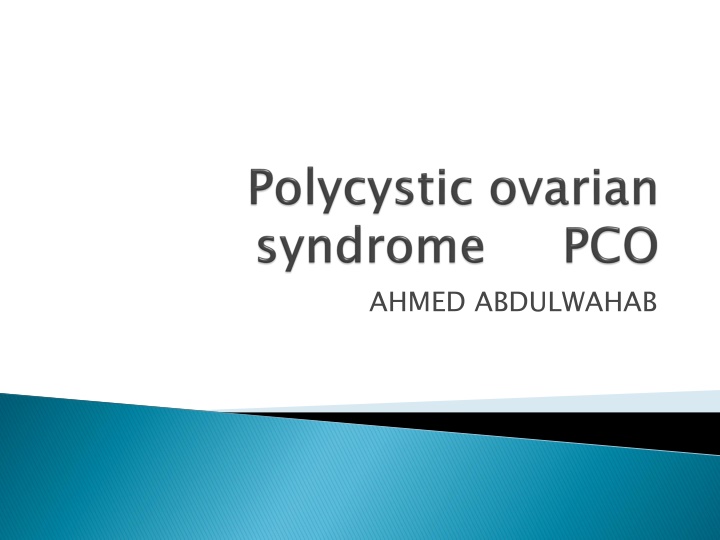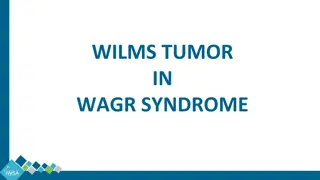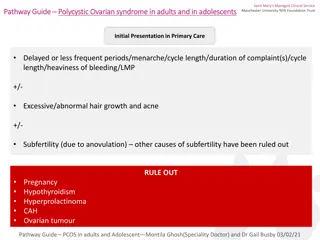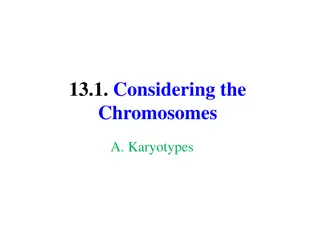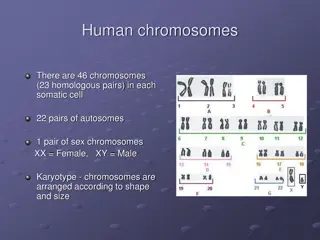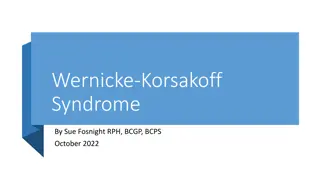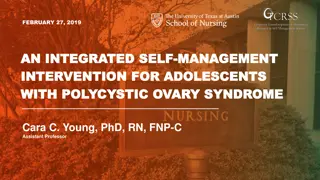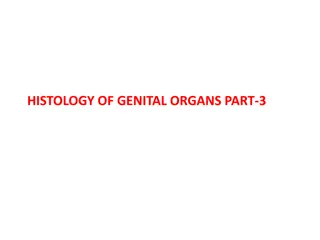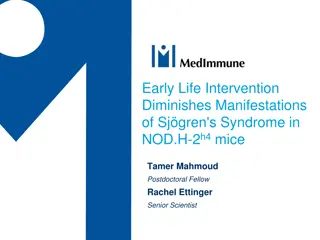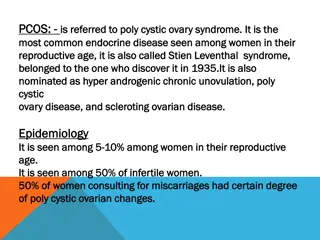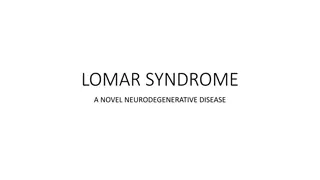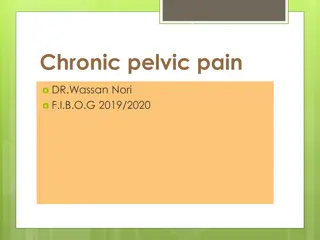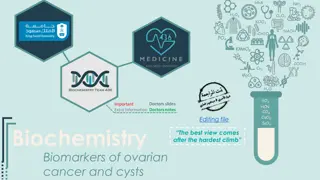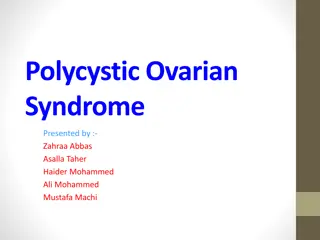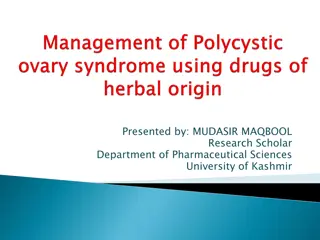Polycystic Ovary Syndrome
Polycystic ovary syndrome (PCOS) is a common endocrine disorder among women, affecting reproductive age individuals. PCOS is believed to have a genetic component but is not fully understood. Symptoms include anovulation, excess androgenic hormones, insulin resistance, menstrual disorders, infertility, high levels of masculinizing hormones, and metabolic syndrome. PCOS is a heterogeneous disorder with uncertain causes, but strong evidence points to it being genetic in nature.
Download Presentation

Please find below an Image/Link to download the presentation.
The content on the website is provided AS IS for your information and personal use only. It may not be sold, licensed, or shared on other websites without obtaining consent from the author.If you encounter any issues during the download, it is possible that the publisher has removed the file from their server.
You are allowed to download the files provided on this website for personal or commercial use, subject to the condition that they are used lawfully. All files are the property of their respective owners.
The content on the website is provided AS IS for your information and personal use only. It may not be sold, licensed, or shared on other websites without obtaining consent from the author.
E N D
Presentation Transcript
Polycystic ovary syndrome is one of the most, common endocrine disorder among women . PCOS has a diverse range of causes that are not entirely understood, but there is evidence that it is largely a genetic disease. Polycystic ovary syndrome (PCOS PCOS), syndrome syndrome,
PCOS produces symptoms in approximately 5% to 10% of women of reproductive age and is thought to be one of the leading causes of female subfertility and the most frequent endocrine problem in women of reproductive age. Finding that the ovaries appear polycystic on ultrasound is common, but it is not an absolute requirement in all definitions of the disorder
The most common immediate symptoms are anovulation, excess androgenic hormones, and insulin resistance. Anovulation results in, irregular menstruation, amenorrhea, and ovulation-related infertility. Hormone imbalance generally causes acne and hirsutism. Insulin resistance is associated with obesity, type 2 diabetes, and high cholesterol levels. The symptoms and severity of the syndrome vary greatly among those affected.
Signs and symptoms. Common symptoms of PCOS include the following: Menstrual disorders: oligomenorrhea (few menstrual periods) or amenorrhea (no menstrual periods), but other types of menstrual disorders may also occur, Infertility This generally results directly from chronic anovulation
High levels of masculinizing hormones: The most common signs are acne , hirsutism and androgenic alopecia . Metabolic syndrome. This appears as a tendency towards central obesity and other symptoms associated with insulin resistance Asians affected by PCOS are less likely to develop hirsutism than those of other ethnic backgrounds
Cause. PCOS is a heterogeneous disorder of uncertain cause ,there is strong evidence that it is a genetic disease. The genetic component appears to be inherited in an autosomal dominant fashion with high genetic penetrance
Diagnosis. Not everyone with PCOS has polycystic ovaries (PCO), nor does everyone with ovarian cysts have PCOS; although a pelvic ultrasound is a major diagnostic tool, it is not the only one. The diagnosis is straightforward using the Rotterdam criteria, even when the syndrome is associated with a wide range of symptoms.
Rotterdam indicated PCOS to be present if any 2 out of 3 criteria are met, in the absence of other entities that might cause these findings oligoovulation and/or anovulation excess androgen activity polycystic ovaries (by gynecologic ultrasound) Rotterdam.
Differential diagnosis Other causes of irregular or absent menstruation and hirsutism, such as hypothyroidism, congenital adrenal hyperplasia (21-hydroxylase deficiency), Cushing's syndrome, hyperprolactinemia, androgen secreting neoplasms , and other pituitary or adrenal disorders, should be investigated Differential diagnosis.
Management. The primary treatments for PCOS include: lifestyle changes, medications and surgery. Goals of treatment may be considered under four categories: Lowering of insulin resistance levels Restoration of fertility Treatment of hirsutism or acne . Restoration of regular menstruation, and prevention of endometrial hyperplasia and endometrial cancer General interventions that help to reduce weight or insulin resistance can be beneficial for all these aims, because they address what is believed to be the underlying cause.
Diet Where PCOS is associated with overweight or obesity, successful weight loss is the most effective method of restoring normal ovulation/menstruation, Medications Reducing insulin resistance by improving insulin sensitivity through medications such as metformin, and the newer (glitazones), have been an obvious approach and initial studies seemed to show effectiveness Diet. Medications.
Infertility Not all women with PCOS have difficulty becoming pregnant. for those that anovulation or infrequent ovulation. For overweight, anovulatory women with PCOS, weight loss and diet adjustments, are associated with resumption of natural ovulation. Infertility.
For those women that after weight loss still are anovulatory or for anovulatory lean women, then the ovulation-inducing medications clomiphene citrate.and gonadotrophins are the principal treatments used to promote ovulation The anti-diabetes medication metformin was recommended treatment for anovulation, but it appears less effective than clomiphene.
Though surgery is not commonly performed, the polycystic ovaries can be treated with a laparoscopic procedure called "ovarian drilling . Often results in either resumption of spontaneous ovulations,or ovulations after adjuvant treatment
Hirsutism When appropriate (e.g., in women of child- bearing age who require contraception), a standard contraceptive pill is frequently effective in reducing hirsutism . Other drugs with anti-androgen effects include flutamide,[and spironolactone . . Metformin can reduce hirsutism, perhaps by reducing insulin resistance. 5-alpha reductase inhibitors (such as finasteride and dutasteride) may also be used, they work by blocking the conversion of testosterone to dihydrotestosterone Hirsutism and acne and acne.
Menstrual irregularity and endometrial hyperplasia If fertility is not the primary aim, then menstruation can usually be regulated with an oral combined contraceptive pills. If menstruation occurs less often or not at all, some form of progestogen replacement is recommended, Menstrual irregularity and endometrial hyperplasia.
Prognosis. A diagnosis of PCOS suggests an increased risk of: Endometrial hyperplasia and endometrial cancer Insulin resistance/Type II diabetes., particularly if obese, they are prone to gestational diabetes. High blood pressure, in particular if obese and/or during pregnancy Depression/Depression with Anxiety. Dyslipidemia . Cardiovascular disease. Miscarriage. Acanthosis nigricans (patches of darkened skin under the arms, in the groin area, on the back of the neck)] The risk of ovarian cancer and breast cancer is not significantly increased overall.
